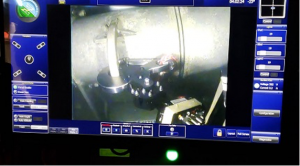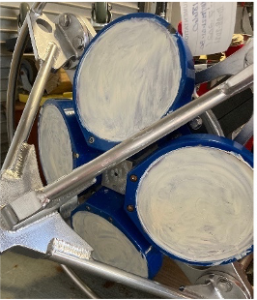Doozy of a Day
Today was the best weather day of the Leg, so we decided to use the ROV (remotely operated vehicle) to recover the last surface mooring. Chris Basque piloted the ROV on the mission to hook a recovery line onto the Multi-Function Node (MFN) of the mooring, with the anchor nested inside, and pull it out of the water onto the ship. It was a long endeavor, the water had high turbidity making it hard to see, and the current was strong. We cheered when the MFN was finally hooked! But had to hold our breath once again…the ROV had tangled itself around the stretch hose that connects the MFN to the Surface Buoy.
It took almost twice as long to untangle the line, but Chris stayed strong and steady, seeing the mission all the way through. Once on board, Dr. Sheri N White and John Lund swiftly moved the ROV out of the way to allow Chris and the deck crew, Nico Llanos and Eric Hutt, to recover the rest of the mooring which includes a Near Surface Instrument Frame (NSIF) and a large Surface Buoy. The recovery of this mooring was done completely opposite to how it’s normally done: first the anchor and MFN, then the buoy and finally the NSIF.

Chris Basque controls the ROV while Irene Duran takes notes on every action of the Ship, ROV, and descent weight. Photo: John Lund ©WHOI.

Screen from ROV camera. Photo: john Lund ©WHOI.
Bonus Thoughts:
I put Desitin, a thick cream meant to prevent diaper rash, on an Acoustic Doppler Current Profiler (ADCP) this morning. The Desitin is so hard to spread! I started putting the it on the wrong ADCP and only stopped when Dr. Sheri N. White asked me what I was doing. I blame it on not having had coffee before getting started. Two of the three surface moorings are in relatively shallow waters, so need some type of biofouling mitigation to prevent biological growth. (The third is in deeper water so does not).

The white coating on the ADCPs is Desitin, also used to prevent diaper rash. Photo: Irene Duran©WHOI.
Mechanisms to mitigate bio-fouling include copper, a UV light, a mechanical wiper, or in this case, Desitin. This is important because the transducers on these sensors send out acoustic pings that bounce off of particles in the water and back onto the transducers to measure the current velocity and direction of the water. If the ADCPs did not have this cream on them, the growth could affect the signal/measurement and ruin the transducers.
Irene Duran